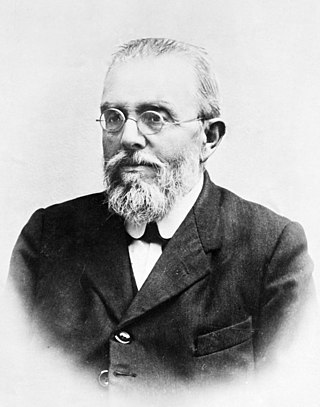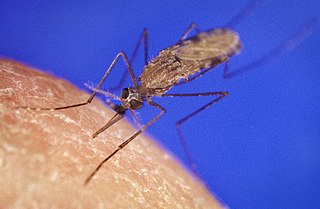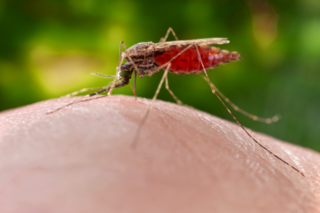
Charles Louis Alphonse Laveran was a French physician who won the Nobel Prize in Physiology or Medicine in 1907 for his discoveries of parasitic protozoans as causative agents of infectious diseases such as malaria and trypanosomiasis. Following his father, Louis Théodore Laveran, he took up military medicine as his profession. He obtained his medical degree from University of Strasbourg in 1867.
WRBU is a television station licensed to East St. Louis, Illinois, United States, broadcasting the Ion Television network to the St. Louis, Missouri area. Owned and operated by the Ion Media subsidiary of the E. W. Scripps Company, the station has offices on Richardson Road in Arnold, Missouri, and its transmitter is located near Missouri Route 21 and East Four Ridge Road in House Springs.

Giovanni Battista Grassi was an Italian physician and zoologist, best known for his pioneering works on parasitology, especially on malariology. He was Professor of Comparative Zoology at the University of Catania from 1883, and Professor of Comparative Anatomy at Sapienza University of Rome from 1895 until his death. His first major research on the taxonomy and biology of termites earned him the Royal Society's Darwin Medal in 1896.

The Anopheles gambiae complex consists of at least seven morphologically indistinguishable species of mosquitoes in the genus Anopheles. The complex was recognised in the 1960s and includes the most important vectors of malaria in sub-Saharan Africa, particularly of the most dangerous malaria parasite, Plasmodium falciparum. It is one of the most efficient malaria vectors known. The An. gambiae mosquito additionally transmits Wuchereria bancrofti which causes lymphatic filariasis, a symptom of which is elephantiasis.
Haemogregarina is a genus of haemoprotozoans, parasitic mainly on cold-blooded vertebrates. They are unicellular organisms which are parasitic in the red blood cells. Haemogregarina infects lower vertebrates as intermediate hosts and leeches.

Anopheles culicifacies is a mosquito species complex and one of the primary vectors of malaria on the Indian subcontinent. It consists of five sibling species, provisionally designated as species A, B, C, D, and E. It prefers to rest indoors in cattle sheds, where it feeds on cattle. The control of A. culicifacies has become difficult due to the development of insecticide resistance against all commonly used insecticides, including new-generation insecticides such as synthetic pyrethroids.

Anopheles earlei is a small insect found throughout North America. The Anopheles earlei larvae are found in cold, clear water in ponds and other small bodies of water that contain plant life or vegetation.

Anopheles quadrimaculatus is a species of mosquito mainly located in Eastern United States, America. The species is a main vector of malaria.

Anopheles is a genus of mosquitoes (Culicidae) with about 484 recognised species.

Mosquito-malaria theory was a scientific theory developed in the latter half of the 19th century that solved the question of how malaria was transmitted. The theory proposed that malaria was transmitted by mosquitoes, in opposition to the centuries-old medical dogma that malaria was due to bad air, or miasma. The first scientific idea was postulated in 1851 by Charles E. Johnson, who argued that miasma had no direct relationship with malaria. Although Johnson's hypothesis was forgotten, the arrival and validation of the germ theory of diseases in the late 19th century began to shed new lights. When Charles Louis Alphonse Laveran discovered that malaria was caused by a protozoan parasite in 1880, the miasma theory began to subside.
The Walter Reed Biosystematics Unit ("WRBU") is a US Army organization that conducts laboratory and field research on the systematics of medically important arthropods in support of epidemiological investigations and disease prevention and control strategies of importance to the military. Research is carried out worldwide, within geographic or faunistic restrictions of the material available and military requirements. Research efforts focus on the development of accurate and reliable means of identifying vectors of arbopathogens of humans.

Anopheles freeborni, commonly known as the western malaria mosquito, is a species of mosquito in the family Culicidae. It is typically found in the western United States and Canada. Adults are brown to black, with yellow-brown hairs and gray-brown stripes on the thorax. Their scaly wings have four dark spots, which are less distinct in the male.
Anopheles nuneztovari is a species of mosquito in the order Diptera native to South America. The species was named by its discoverer, Arnoldo Gabaldón, to honor the Venezuelan entomologist Manuel Núñez Tovar.
Anopheles bellator is a species of mosquito mainly located in southeast of State of São Paulo, Brazil, is a main vector of malaria.

Anopheles maculipennis is a species of mosquito that can be found mostly in Europe and New Zealand. It is one of the main vectors of malaria.
Anopheles moucheti is a species of mosquito. It is an anthropophile. It can be mainly located in Congo Basin forest, Central Africa. It was the main vector of malaria.

Anopheles merus is a species of mosquito that can be found in coastal areas of Eastern and Southern Africa. The species is a main vector of malaria.

Anopheles quadriannulatus is a species of mosquito that can be found in Sub-Saharan Africa with the exception of West Africa and Madagascar. The species is a vector of malaria.

Anopheles plumbeus is a species of mosquito found in Europe and can also be found in the near East and northern Africa. It is anthropophilic and can be a nuisance mosquito, biting persistently during dawn, dusk and also during the day. A. plumbeus can transmit the malaria agent Plasmodium falciparum. A. plumbeus has been collected from forested areas, but also from rural and urban areas. It breeds in treeholes, water-filled containers or discarded tyres. The species is similar in appearance to A. claviger.













